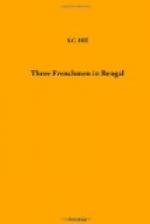“As the ships of war were what we had most to fear from, we constructed on the river bank a battery of 6 guns, four of which covered the approach to the Fort. From the foot of the battery a bank twenty-two feet high stretching to the Fort, was begun, so as to protect the curtain on this side from the fire of the ships, but it was not finished. We had also to attend to the inhabited portion of the town; it was impossible to do more, but we determined to protect it from a surprise, and so ditches were dug across the streets and outposts established."[31]
It was this waste of valuable time upon the defence of the town that a capable engineer would have saved Renault from the mistake of committing. Had he limited his efforts to strengthening the walls of the Fort and cleared away the surrounding houses, he would have been not only stronger against the attack of the land force, but also in a much better position to resist the ships.
The issue of the Nawab’s attack on Calcutta has already been told. He was so depressed by his failure that he now treated Renault with the greatest respect, and it was now that he gave him the sum of money—a lakh of rupees, then worth L12,500—which he spent on provisions and munitions of war. Renault says:—
“The Nawab’s envoy further gave me to understand that he was, in his heart, enraged with the English, and continued to regard them as his enemies. In spite of this we saw clearly from the treaty just made” (with the English) “that we should be its victims, and knowing Siraj-ud-daula’s character, his promise to assist me strongly if the English attacked us did not quiet my mind. I prepared for whatever might happen by pressing on our preparations and collecting all kinds of provisions in the Fort.”
The Nawab and the English concluded a treaty of peace and alliance on the 9th of February, 1757. Renault mentions no actual treaty between the Nawab and the French, but the French doctor referred to in a note above asserts that the Nawab demanded that the Council should bind itself in writing,




